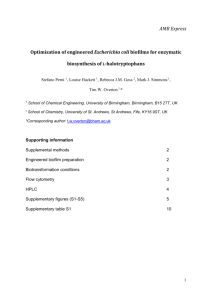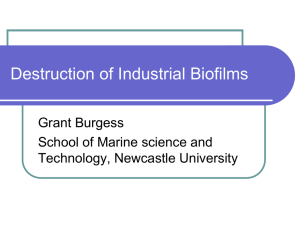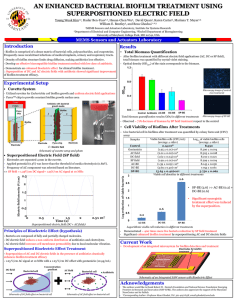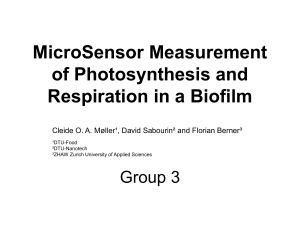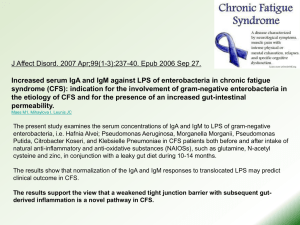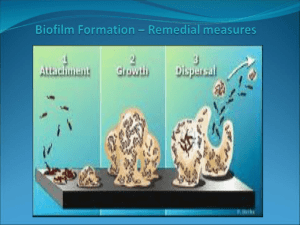Eravacycline (TP-434) - Tetraphase Pharmaceuticals
advertisement
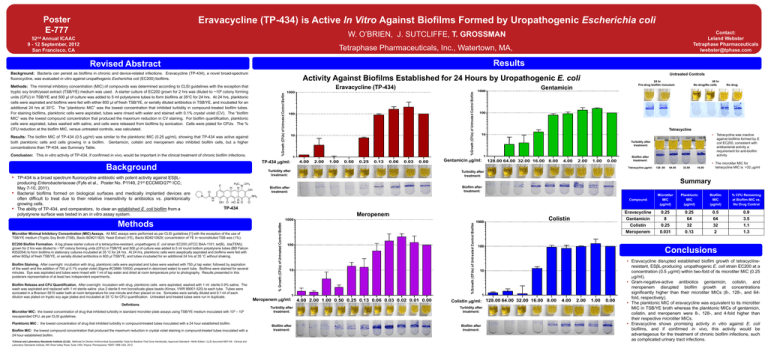
Poster E-777 Eravacycline (TP-434) is Active In Vitro Against Biofilms Formed by Uropathogenic Escherichia coli W. O’BRIEN, J. SUTCLIFFE, T. GROSSMAN 52nd Annual ICAAC 9 - 12 September, 2012 San Francisco, CA Tetraphase Pharmaceuticals, Inc., Watertown, MA, Results Revised Abstract Background: Bacteria can persist as biofilms in chronic and device-related infections. Eravacycline (TP-434), a novel broad-spectrum fluorocycline, was evaluated in vitro against uropathogenic Escherichia coli (EC200) biofilms. Conclusion: This in vitro activity of TP-434, if confirmed in vivo, would be important in the clinical treatment of chronic biofilm infections. 1 4.00 2.00 1.00 0.50 0.25 0.13 0.06 0.03 0.00 Turbidity after treatment: Gentamicin 48 hr No drug/No cells No drug 100 Tetracycline • 10 Turbidity after treatment: 1 Gentamicin g/ml: 128.00 64.00 32.00 16.00 8.00 4.00 2.00 1.00 0.00 Biofilm after treatment: 128 .00 64.00 32.00 Tetracycline was inactive against biofilms formed by E. coli EC200, consistent with antibacterial activity a requirement for anti-biofilm activity • The microtiter MIC for tetracycline MIC is >32 g/ml 16.00 Turbidity after treatment: Summary Biofilm after treatment: Biofilm after treatment: Compound Microtiter MIC (µg/ml) Planktonic MIC (µg/ml) Biofilm MIC (µg/ml) % CFU Remaining at Biofilm MIC vs. No Drug Control Eravacycline Gentamicin Colistin Meropenem 0.25 8 0.25 0.031 0.25 64 32 0.13 0.5 64 32 2 0.9 3.5 1.1 1.3 TP-434 Meropenem 1000 Methods Microtiter Minimal Inhibitory Concentration (MIC) Assays. All MIC assays were performed as per CLSI guidelines [1] with the exception of the use of TSB/YE medium (Tryptic Soy Broth (TSB), Bacto BD#211825; Yeast Extract (YE), Bacto BD#210929; concentration of YE in reconstituted TSB was (1%). EC200 Biofilm Formation. A log phase starter culture of a tetracycline-resistant, uropathogenic E. coli strain EC200 (ATCC BAA-1161; tet(B), bla(TEM)) grown for 2 hrs was diluted to ~106 colony forming units (CFU) in TSB/YE and 500 µl of culture was added to 5 ml round bottom polystyrene tubes (BD Falcon #352054) to form biofilms in stationary cultures incubated at 35 °C for 24 hrs. At 24 hrs, planktonic cells were aseptically aspirated and biofilms were fed with either 600µl of fresh TSB/YE, or serially diluted antibiotics in 600 µl TSB/YE, and tubes incubated for an additional 24 hrs at 35 °C without shaking. Biofilm Staining. After overnight incubation with drug, planktonic cells were aspirated and tubes were washed with 750 µl tap water, followed by aspiration of the wash and the addition of 750 µl 0.1% crystal violet (Sigma #C3886-100G0; prepared in deionized water) to each tube. Biofilms were stained for several minutes. Dye was aspirated and tubes were rinsed with 1 ml of tap water and dried at room temperature prior to photography. Results presented in this posterare representative of at least two independent experiments. Biofilm Release and CFU Quantification. After overnight incubation with drug, planktonic cells were aspirated, washed with 1 ml sterile 0.9% saline. The wash was aspirated and replaced with 1 ml sterile saline plus 2 sterile 6 mm borosilicate glass beads (Kimax, VWR 89001-520) to each tube. Tubes were sonicated in a Branson 5510 water bath at room temperature for one minute and then placed on ice. Sonicates were serially diluted and 0.1 ml of each dilution was plated on tryptic soy agar plates and incubated at 35 °C for CFU quantification. Untreated and treated tubes were run in duplicate. Definitions Microtiter MIC: the lowest concentration of drug that inhibited turbidity in standard microtiter plate assays using TSB/YE medium inoculated with resuspended CFU, as per CLSI guidelines. 105 – 106 Planktonic MIC : the lowest concentration of drug that inhibited turbidity in compound-treated tubes inoculated with a 24 hour established biofilm. Biofilm MIC: the lowest compound concentration that produced the maximum reduction in crystal violet staining in compound-treated tubes inoculated with a 24 hour established biofilm. 1Clinical 10 and Laboratory Standards Institute (CLSI). Methods for Dilution Antimicrobial Susceptibility Tests for Bacteria That Grow Aerobically; Approved Standard—Ninth Edition. CLSI document M07-A9 . Clinical and Laboratory Standards Institute, 940 West Valley Road, Suite 1400, Wayne, Pennsylvania 19087-1898 USA, 2012. % Growth (CFUs) of Untreated Control Biofilm • 100 1000 Untreated Controls 24 hr Pre-drug biofilm inoculum Tetracycline µg/ml: % Growth (CFUs) of Untreated Control Biofilm • 1000 TP-434 g/ml: Background TP-434 is a broad spectrum fluorocycline antibiotic with potent activity against ESβLproducing Enterobacteriaceae (Fyfe et al., Poster No. P1149, 21st ECCMID/27th ICC; May 7-10, 2011). Bacterial biofilms formed on biological surfaces and medically implanted devices are often difficult to treat due to their relative insensitivity to antibiotics vs. planktonically growing cells. The ability of TP-434, and comparators, to clear an established E. coli biofilm from a polystyrene surface was tested in an in vitro assay system. Eravacycline (TP-434) % Growth (CFUs) of Untreated Control Biofilm Results: The biofilm MIC of TP-434 (0.5 µg/ml) was similar to the planktonic MIC (0.25 µg/ml), showing that TP-434 was active against both planktonic cells and cells growing in a biofilm. Gentamicin, colistin and meropenem also inhibited biofilm cells, but a higher concentrations than TP-434, see Summary Table. Results Activity Against Biofilms Established for 24 Hours by Uropathogenic E. coli % Growth (CFUs) of Untreated Control Biofilm Methods: The minimal inhibitory concentration (MIC) of compounds was determined according to CLSI guidelines with the exception that tryptic soy broth/yeast extract (TSB/YE) medium was used. A starter culture of EC200 grown for 2 hrs was diluted to ~106 colony forming units (CFU) in TSB/YE and 500 µl of culture was added to 5 ml polystyrene tubes to form biofilms at 35°C for 24 hrs. At 24 hrs, planktonic cells were aspirated and biofilms were fed with either 600 µl of fresh TSB/YE, or serially diluted antibiotics in TSB/YE, and incubated for an additional 24 hrs at 35°C. The “planktonic MIC” was the lowest concentration that inhibited turbidity in compound-treated biofilm tubes. For staining biofilms, planktonic cells were aspirated, tubes were rinsed with water and stained with 0.1% crystal violet (CV). The “biofilm MIC” was the lowest compound concentration that produced the maximum reduction in CV staining. For biofilm quantification, planktonic cells were aspirated, tubes washed with saline, and cells were released from biofilms by sonication. Cells were plated for CFUs. The % CFU reduction at the biofilm MIC, versus untreated controls, was calculated. • Contact: Leland Webster Tetraphase Pharmaceuticals lwebster@tphase.com 100 10 Meropenem g/ml: 1 4.00 2.00 1.00 0.50 0.25 0.13 0.06 0.03 0.02 0.01 0.00 1000 Colistin 100 Conclusions 10 1 Colistin g/ml: 128.00 64.00 32.00 16.00 8.00 Turbidity after treatment: Turbidity after treatment: Biofilm after treatment: Biofilm after treatment: 4.00 2.00 1.00 0.00 • Eravacycline disrupted established biofilm growth of tetracyclineresistant, ESβL-producing uropathogenic E. coli strain EC200 at a concentration (0.5 g/ml) within two-fold of its microtiter MIC (0.25 g/ml). • Gram-negative-active antibiotics gentamicin, colistin, and meropenem disrupted biofilm growth at concentrations significantly higher than their microtiter MICs (8-, 128-, and 64fold, respectively). • The planktonic MIC of eravacycline was equivalent to its microtiter MIC in TSB/YE broth whereas the planktonic MICs of gentamicin, colistin, and meropenem were 8-, 128-, and 4-fold higher than their respective microtiter MICs. • Eravacycline shows promising activity in vitro against E. coli biofilms, and if confirmed in vivo, this activity would be advantageous for the treatment of chronic biofilm infections, such as complicated urinary tract infections.

